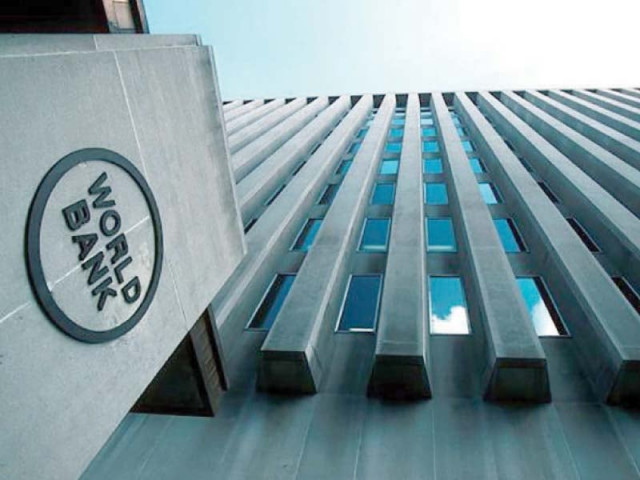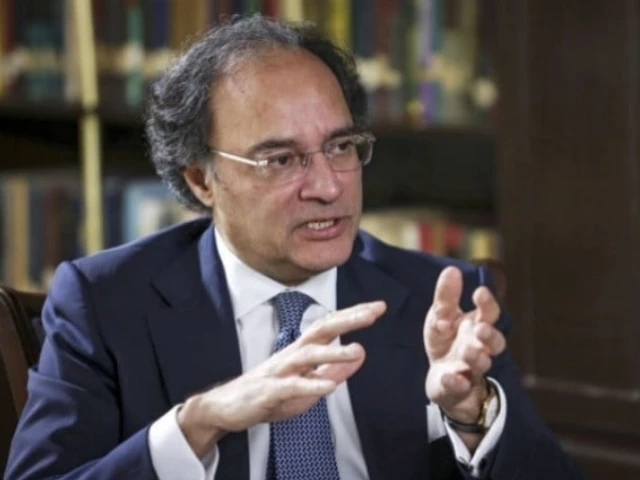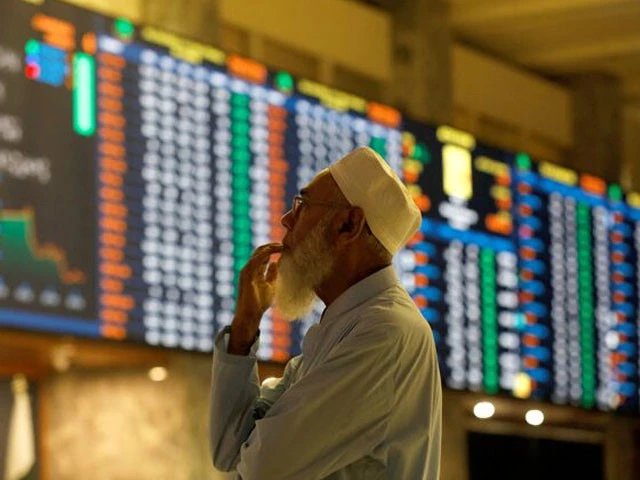Business
Poverty down, but no lift in living standards: WB | The Express Tribune

Lender bases assessment on simulation data; Floods in Punjab deepen rural household losses
World Bank. PHOTO: FILE
ISLAMABAD:
The World Bank claimed on Tuesday that Pakistan’s poverty rate decreased to 22.2% and it would sink further to pre-Covid levels this year, yet reiterating that the country’s current economic growth rate was not enough to reduce poverty and improve the living standard.
The paradoxical statements by the lender underscore the emergent need for the latest credible data, as the World Bank too has assumed the poverty reduction by running a simulation exercise on 2019 consumption data of Pakistan.
The Washington-based lender released its flagship annual ‘Pakistan Development Update’ report, which showed a declining trend in poverty, marking a departure from it’s a month-old statement that the current economic model cannot reduce poverty.
The World Bank on Tuesday also upward adjusted Pakistan’s economic growth forecast to 3% for this fiscal year, which is slightly better than its few days old forecast of 2.7%.
While projecting the poverty rate already declined to 22.2% and to reduce further to 21.5% in this fiscal year, the World Bank economist, Mukhtarul Hasan, also said that the current economic growth rate was “not enough” to improve the living standard and reduce poverty.
Responding to a question by The Express Tribune, Christina Wieser, the bank’s lead poverty expert, refuted that there was any pressure by the government to change the last month’s forecast of poverty going northbound.
Last month, the World Bank had said that “Pakistan’s growth model that supported initial poverty reduction has proven insufficient to sustain progress and poverty is on the rise since 2021-22”.
Wieser clarified that in the absence of the latest consumption data, the World Bank has used some strong assumptions in simulation models, which showed poverty declining. She disclosed that the World Bank had assumed that the increase in sectoral growth is also fully passed on to labour wages.
But this assumption that may not be true as even some government departments are not paying the minimum Rs37,000 per month wage to its daily wage employees and it did not increase the wages in this budget.
Wieser further said that the World Bank will make further adjustments in its poverty estimates once the latest ‘Household Integrated Economic Survey’ data is available in next couple of months.
While presenting the findings here at the World Bank’s local office, Wieser said that higher growth and lower inflation contributed to a decrease in poverty, with the poverty rate, measured at the national poverty line, estimated to have fallen to 22.2% in the last fiscal year from 25.3% of June 2024.
Strong growth in the construction and logistics sectors, which employ around one-quarter of all working poor, boosted labour incomes, said Wieser. However, last month the World Bank said that due to lower wages in the construction sector, the poverty was on the rise in Pakistan.
She said that a sharp drop in food inflation reduced price pressures and improved the purchasing power of the poor, who spend roughly 45% of their household budgets on food. But the report underlined that the floods are anticipated to affect poor and vulnerable rural households, who face the loss of agricultural assets, with limited savings and inadequate coping mechanisms.
These vulnerabilities are compounded by rising food inflation and the volatility of informal jobs in low skill industry and services sectors, according to the report. “As a result, the pace of poverty reduction is expected to slow, with poverty declining only modestly to 21.5% in fiscal year 2026 and to 20.6% in fiscal year 2027.
The report also explicitly stated that since 2019, Pakistan has undergone several major crises, including the Covid-19 pandemic, devastating floods in 2022, and a macroeconomic crisis made more precarious by increased political uncertainty.
It is expected that these shocks had a profound impact on household welfare and poverty rates in the country, but recent survey data is not available to quantify these. In this context, welfare levels for Pakistan can be estimated using a micro-simulation tool which models the path of household welfare based on macroeconomic indicators.
The report added that the underlying assumption for this approach is that macroeconomic indicators, such as sectoral GDP growth, inflation, and changes in the real value of private and public transfers, directly influence households’ real labour and non-labour incomes, which in turn has a direct bearing on consumption levels and poverty.
Bolormaa Amgaabazar, the World Bank’s country head, said that recent floods, have complicated the outlook, imposing significant human costs and economic losses, thereby dampening growth prospects, and posing additional challenges to macroeconomic stability amid constrained fiscal space, high external financing needs, and major regional and global uncertainties.
Budget is vulnerable
The report reflected that meeting the budget targets of economic growth, provincial cash surpluses and budget deficit would not be possible. The budget continues to be predicated on optimistic growth targets and revenues, according to the report. It added that the budget estimates real GDP growth of 4.2% is significantly above World Bank and IMF forecasts.
Increases in provincial surpluses carry risks due to floods, said the lender, adding that the federal budget projects a 45.1% increase in provincial surpluses, a key component of Pakistan’s fiscal consolidation strategy.
This increase hinges on the successful implementation of provincial Agriculture Income Tax (AIT) regimes, effective since January 1, 2025, with tax liabilities for the second half of FY25 expected to be collected in the first quarter of FY26.
Provinces are also expected to strengthen GST collection of services. However, these targets carry significant risks. Provinces will need to curb expenditure growth to maintain surpluses, a task that may prove difficult if revenue performance falls short, said the lender.
The recent floods, particularly in Punjab, threaten agricultural output. Mukhtarul Hasan said that based on the assumption that the flood impacts are limited, fiscal discipline is maintained, and the IMFEFF programme stays on track, economic growth is expected to remain at 3%. A few days ago, the World Bank had cut the economic growth projection to 2.6%.
Inflation & external sector
The flood-related shock to food supply is expected to push inflation above earlier projections, peaking at 7.2% in the current fiscal year, which is slightly higher than the official target.
The current account is projected to return to a small deficit of 0.3% of GDP in this fiscal year as remittances and lower oil prices offset export losses and higher food imports, according to the lender. It said that as post-flood recovery boosts import demand and remittances normalise, the deficit is expected to widen further in the next fiscal year.
The World Bank has sought more visibility in the movement of exchange rate market. It has recommended enabling a deep and liquid interbank market without SBP intermediation and broader participation from market players, including exporters, importers, and foreign investors.
The lender has demanded publishing detailed data on interbank market transactions, including volumes and participants and phasing out ad hoc interventions so that the exchange rate reflects actual supply and demand.
Anna Twum, the bank’s expert on international trade, said that Pakistan’s exports were hardly equal to 0.1% of the global exports, which in the case of India was over 5%. She cautioned that 70% of Pakistan’s exports were at risk due to new standards being introduced by the European Union (EU).
Budget deficit
The lender said that fiscal consolidation is expected to continue under the ongoing IMF programme. However, flood-related relief and reconstruction needs will add to spending pressures, with the fiscal deficit projected to remain elevated at 5.4% of GDP in FY26, which is above the official target.
The World Bank said that public debt is expected to remain elevated to 76% of the GDP due to modest flood related spending and elevated financing needs. The gross financing needs will nevertheless remain high, reflecting maturing short-term debt, repayments to multilateral and bilateral creditors, and upcoming Eurobond maturities, according to the lender.
Business
Investment focus: CII pitches reforms for Budget 2026-27; industry body seeks capex push – The Times of India

The Confederation of Indian Industry (CII) has urged the Centre to adopt a wide-ranging set of reforms in the Union Budget 2026-27 to reinforce India’s investment-led growth cycle and sustain its position as one of the world’s fastest-expanding major economies, PTI reported.In a detailed submission for the upcoming Budget, CII recommended raising central capital expenditure by 12% and increasing capex support to states by 10% in FY27, launching a Rs 150 lakh crore National Infrastructure Pipeline (NIP) 2.0 for 2026-32, and introducing incremental tax credits or compliance relaxations for companies achieving notable milestones in investment, output or tax contribution. The industry body also sought an NRI Investment Promotion Fund and the reinstatement of accelerated depreciation benefits to spur fresh capital expenditure, especially for MSMEs and manufacturing sectors, without triggering Minimum Alternate Tax (MAT) liability.CII said strengthening the National Investment and Infrastructure Fund (NIIF) through a proposed Sovereign Investment Strategy Council (SIFC) would help align investments with national economic priorities. The Union Budget for FY27 is scheduled to be presented on February 1.According to the industry chamber, replacing rigid annual fiscal-deficit rules with an economic-cycle-based public debt framework would bolster resilience and allow counter-cyclical flexibility during global shocks, while ensuring the credibility of medium-term debt sustainability.“The forthcoming Union Budget 2026-27 has to serve the dual role of stabiliser and growth enabler, and promoting investments will be one of the most critical components in this regard,” said CII Director General Chandrajit Banerjee.He added that CII’s proposals centre on fiscal prudence, capital efficiency and building investor confidence.CII stressed that public capex has been the backbone of India’s post-pandemic recovery, crowding in private investment. To improve execution, it suggested creating a Capital Expenditure Efficiency Framework (CEEF) for selecting high-impact projects and monitoring outcomes based on productivity and regional growth spillovers.The chamber said facilitating private and foreign investment will be essential in driving the next phase of expansion. It proposed tax incentives linked to new investment and production milestones in high-growth areas such as clean energy, electronics, semiconductors and logistics. It also suggested the creation of an NRI Investment Promotion Fund — a government-private entity with up to 49% government stake — to mobilise overseas and institutional capital into infrastructure and emerging sectors.Further, easing external commercial borrowing norms with higher limits, longer tenures and partial risk cover for infrastructure and manufacturing projects would improve access to foreign capital, CII said. A single-window clearance system with deemed approval within 60-90 days for large FDI proposals was also recommended to accelerate big-ticket investment decisions.To deepen engagement with global investors, CII proposed an India Global Economic Forum — a government-led platform bringing together sovereign wealth funds, pension funds, private equity firms and multinational corporations for structured dialogue with senior policymakers.“An investment-driven growth strategy, anchored in fiscal credibility and institutional reforms, will define India’s next development phase,” Banerjee said.
Business
Wealth outlook: India set for multi-trillion-dollar expansion; MoSL sees $12 trillion value boost ahead – The Times of India

India is poised to enter a decisive phase of economic expansion that could redefine long-term wealth creation, according to Motilal Oswal Financial Services’ 30th Wealth Creation Study, which projects a sharp acceleration in the country’s economic and consumption landscape over the next 17 years, ANI reported.The study draws a parallel with the last growth cycle, when India’s GDP expanded fourfold from $1 trillion in 2008 to $4 trillion in 2025, and says a similar trajectory could take the economy to $16 trillion by 2042. Unlike the previous phase, which added $3 trillion in absolute GDP, the next leg is expected to add $12 trillion, signalling what the brokerage terms a much stronger wealth-effect that could significantly lift consumption, investment and corporate profitability.A major pillar of this expansion is expected to be the financial services ecosystem, with cumulative household savings estimated at $47 trillion over the period. Banks, NBFCs, insurers, AMCs, wealth managers, capital market platforms and other intermediaries are expected to play a central role in channelling these savings into productive financial assets as households move further towards formal wealth creation avenues.Per capita income, currently around $2,600, is projected to quadruple to $10,400 by 2042, pushing millions of Indians into higher consumption brackets. The study says this transition will strengthen discretionary categories including white goods, food-tech platforms, quick commerce, healthcare, travel, telecom and allied services, accelerating the shift from necessity spending to lifestyle-driven consumption.On automobiles, MoSL highlights significant headroom for growth. Penetration levels of cars, SUVs, two-wheelers and three-wheelers remain well below those of peer economies with similar income levels. As affordability improves and financing deepens, ownership ratios are expected to rise across cities and semi-urban markets.Real estate is also set to be a key beneficiary, with strong demand expected for credible developers, particularly in the premium and luxury segments. Rising household wealth, better affordability and higher preference for quality housing are likely to sustain sectoral momentum.Overall, the study notes that the next 17 years could mark a step-change in India’s economic and wealth trajectory. With expansion taking place on a much larger base, the impact of the wealth-effect is expected to be far deeper than previous cycles, creating long-term opportunities across financial services, consumption-led industries, automobiles and real estate.
Business
Work-life balance push: Right to Disconnect Bill sparks corporate debate; firms say boundaries help but flexibility key – The Times of India

The Right to Disconnect Bill, 2025 — a private member’s bill introduced in Parliament last week — has reopened the conversation on work-life boundaries, even though experts say it is unlikely to become law anytime soon. The legislation, moved by NCP MP Supriya Sule, proposes giving employees the legal right to ignore work-related communication outside designated working hours. While private member’s bills seldom translate into statutes, they often succeed in spotlighting issues of public concern — and this one has already triggered strong reactions across India Inc, according to an ET report.Executives at Mercedes-Benz India, RPG Group, Bombay Realty (Wadia Group), Grant Thornton Bharat, TeamLease Services and Randstad India said the move underlines a growing cultural shift toward employee well-being. Several countries including France, Belgium, Ireland and Australia have already enacted similar rights, experts noted. “Its stated intent is broadly aligned with our approach to employee well-being in a holistic manner,” an RPG Group spokesperson told ET. The conglomerate has implemented flexible hours, hybrid models and firm boundaries such as CEAT’s 8 pm–8 am no-work window, no-work weekends and silent lunch hours. “We believe a happy work environment leads to happy employees, who in turn will deliver their best,” the spokesperson said, ET quoted.Mercedes-Benz India MD and CEO Santosh Iyer said the company’s hybrid working model — allowing employees to work from home twice a week — supports “quality time with family members” while maintaining accountability. “There is higher trust in hybrid culture,” he added. Randstad India CEO Viswanath PS described the proposed law as a “coming of age” moment for the Indian workforce. “This invites us to dismantle the ‘always-on’ habit,” he said, arguing that leadership must shift focus from “input metrics” like hours worked to “impact metrics”.Grant Thornton Bharat partner Priyanka Gulati said conversations with about 20 client organisations across sectors show broad support for clearer boundaries. “Self-accountability is more powerful in mature organisations where employees measure their energy, not just their hours,” she said. At the same time, she noted that companies expect employees to stretch when business demands it. TeamLease Digital CEO Neeti Sharma said defined hours — 9 am to 6 pm, Monday to Friday — act as a helpful baseline, particularly for dispersed teams. “Companies also need flexibility for global collaboration, time zones and project-based work,” she said.Experts stressed that young professionals often hesitate to say no, which makes clearer norms important. Lydia Naik, Group CHRO at Bombay Realty (Wadia Group), said there is “no one-size-fits-all” for work hours. “What truly matters is the quality of work, personal balance and ensuring workloads are realistic,” she said. Despite the bill’s uncertain legislative future, the renewed debate suggests a shift in how Indian workplaces view well-being, productivity and boundaries — with corporate India acknowledging that the era of being perpetually “online” may be nearing its end.
-

 Politics6 days ago
Politics6 days agoThailand launches air strikes against Cambodian military: army
-

 Tech1 week ago
Tech1 week agoWIRED Roundup: DOGE Isn’t Dead, Facebook Dating Is Real, and Amazon’s AI Ambitions
-

 Politics6 days ago
Politics6 days agoZelenskiy says Ukraine’s peace talks with US constructive but not easy
-

 Fashion6 days ago
Fashion6 days agoGermany’s LuxExperience appoints Francis Belin as new CEO of Mytheresa
-

 Business1 week ago
Business1 week agoNetflix to buy Warner Bros. film and streaming assets in $72 billion deal
-

 Politics1 week ago
Politics1 week ago17 found dead in migrant vessel off Crete: coastguard
-

 Tech1 week ago
Tech1 week agoMIT researchers “speak objects into existence” using AI and robotics
-

 Tech5 days ago
Tech5 days agoJennifer Lewis ScD ’91: “Can we make tissues that are made from you, for you?”












